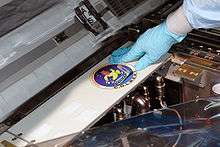Decal
A decal (/ˈdiːkæl/, US also /dɪˈkæl/, CA /ˈdɛkəl/) or transfer is a plastic, cloth, paper, or ceramic substrate that has printed on it a pattern or image that can be moved to another surface upon contact, usually with the aid of heat or water.

The word is short for decalcomania, which is the English version of the French word décalcomanie.
The technique was invented by Simon François Ravenet, an engraver from France who later moved to England and perfected the process he called "décalquer" (which means to copy by tracing); it became widespread during the decal craze or mania of the late 19th century.
Properties
A decal consists of the following layers from top to bottom:
- A paper or film facestock makes up the top layer of the label stock. The printing is done on the upper side of the facestock.
- An adhesive layer is applied to the bottom of the facestock.
- A silicone or release coating layer is applied to the upper side of the backing material.
- A paper or film liner provides the bottom layer of the label stock.
Different variations of decals include: water-slide or water-dip; and vinyl peel-and-stick. A water-slide (or water-dip) decal is screen-printed on a layer of water-soluble adhesive on a water-resistant paper, that must first be dipped in water prior to its application.
Upon contact with water, the glue is loosened and the decal can be removed from its backing; overlong exposure, however, dissolves the glue completely causing the decal to fail to adhere.
A peel-and-stick decal is actually not a decal as described above, but a vinyl sticker with adhesive backing, that can be transferred by peeling off its base. The sign industry calls these peel-and-stick vinyl stickers vinyl-cut-decals.
Modern production process
Mass-production of vinyl decals starts with large rolls of vinyl sheet. Vinyl is fed through a cutting plotter or large-format printer/cutter which prints the desired image and cuts out the desired shapes. Designs are typically created using specialized computer software and sent to the machines electronically. After the patterns are cut, excess vinyl on the sheet is removed in a process called weeding.[1] Finally, a paper pre-mask can be applied to the top of the vinyl design allowing easy application of multiple letters and shapes.
A recent innovation involves the inclusion of a radio frequency identification (RFID) circuit (chip and antenna) in the paper or film facestock.
Applications
Decals are commonly used on hot rod automobiles and plastic models. They are also used on guitars as a way of personalizing them.
Government agencies (and some private-public partnerships) use decals on vehicles for identification. These decals are referred to as fleet markings and are required by law on all fire and law enforcement vehicles in the US. Most fleet markings are created from reflective vinyl with an adhesive backing that is applied in a peel-and-stick manner.
Methods of printing
See also
- Bumper sticker
- Ceramic decal
- Country tag
- Dry transfer
- Lithography
- Sticker
- Wall decal
References
External links

- Decal (art) at the Encyclopædia Britannica